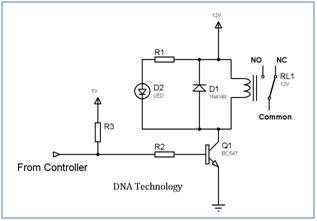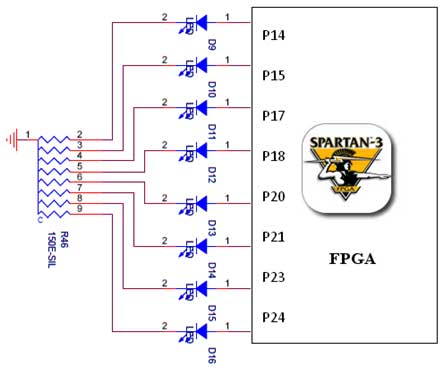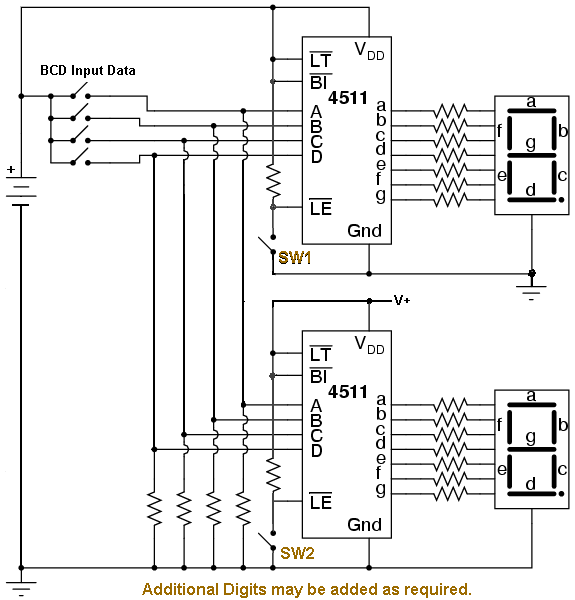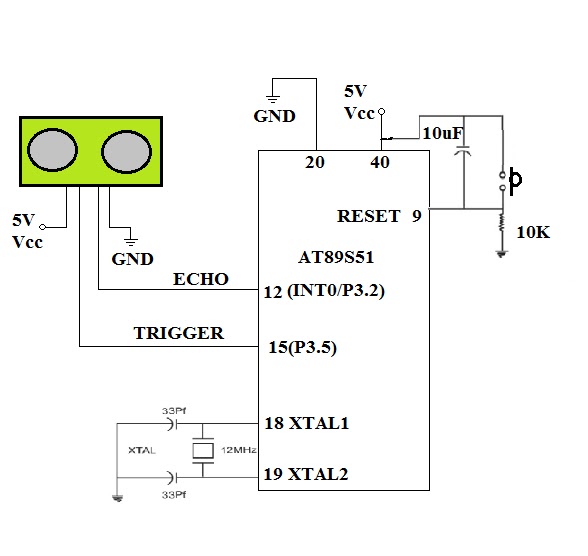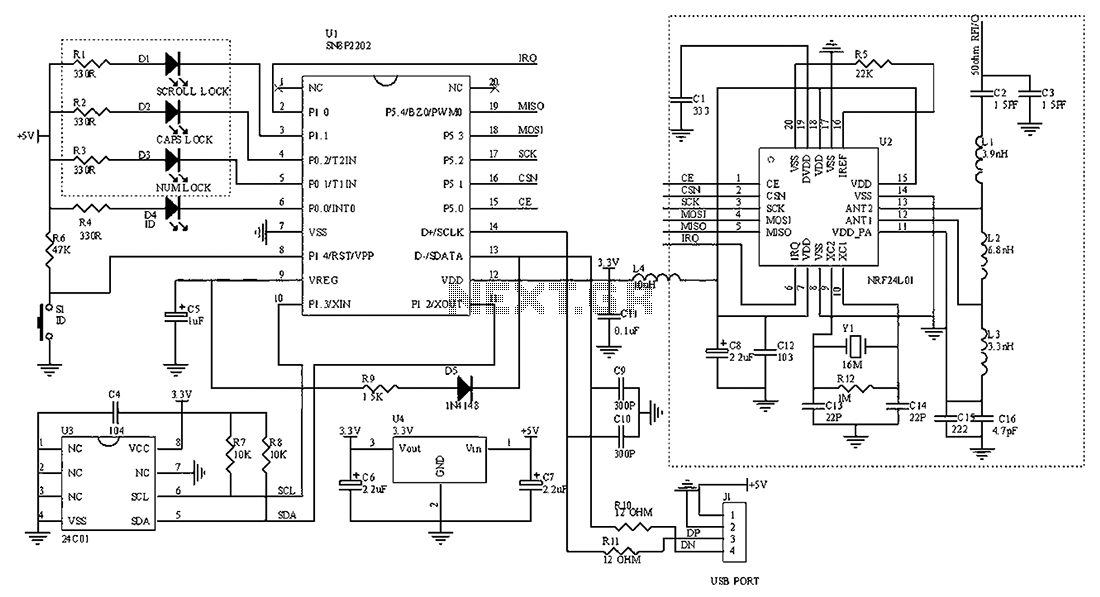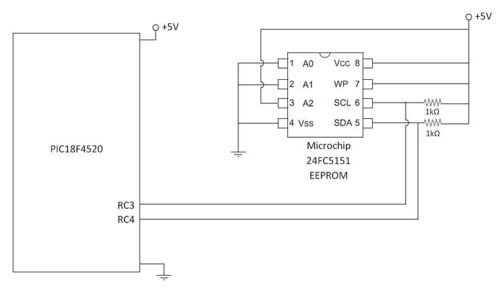
Keyboard Interfacing to 8051
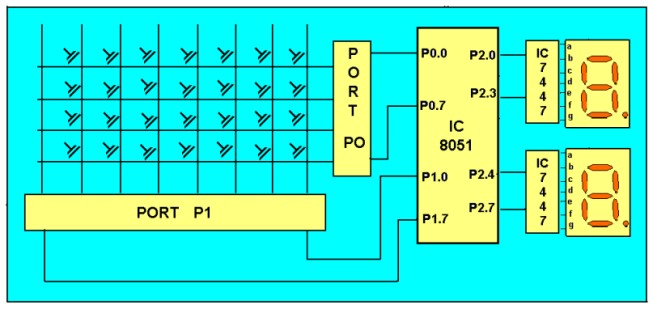
The keyboard being interfaced is a matrix keyboard designed with specific rows and columns. These rows and columns connect to the microcontroller via its ports, specifically the 8051 microcontroller. An 8x8 matrix keyboard is typically used, allowing connection to two ports of the 8051 for the rows and columns. When a key is pressed, a row and a column are shorted through the pressed key, while all other keys remain unactivated. This action causes a bit in the port to go high, indicating to the microcontroller that a key has been pressed. The corresponding column of the pressed key can then be identified. To determine which key was pressed, the system first checks the specific row and then the corresponding column of the keyboard. To identify the row of the pressed key, one row is set high by making a bit in the output port of the 8051 high, continuing this process until the correct row is identified. Once the row is determined, the next task is to find the column of the pressed key. The column is detected using the contents of the input ports in conjunction with a counter. The input port's content is rotated with carry until the carry bit is set. The counter's content is then compared and displayed. The display utilizes a seven-segment display and a BCD to seven-segment decoder IC 7447. The 8051 microcontroller features four I/O ports (P0 to P3), each with eight I/O pins: P0.0 to P0.7, P1.0 to P1.7, P2.0 to P2.7, and P3.0 to P3.7. Port P1 serves as the input port, port P0 as the output port, and port P2 is designated for displaying the number of the pressed key. When a key press is detected, the contents of the accumulator are rotated right through the carry until the carry bit is set, while simultaneously incrementing the count in the counter until the carry is found.
The matrix keyboard interface with the 8051 microcontroller operates on the principle of scanning rows and columns to identify key presses. The matrix configuration allows for a compact design, where multiple keys can be monitored using fewer pins. In this setup, two ports of the microcontroller are dedicated to the keyboard matrix: one for output (to drive the rows) and one for input (to read the columns).
When a key is pressed, it creates a connection between a specific row and column, thus generating a unique signal that can be detected by the microcontroller. The scanning process begins by setting one of the row pins high while keeping the others low, effectively energizing that row. The microcontroller then checks each column pin in sequence to see if any of them are also high, indicating that a key in that row has been pressed.
The detection mechanism uses a counter to rotate the input port contents until a high signal is detected, signaling the presence of a pressed key. The accumulator's contents are manipulated to facilitate this detection, ensuring that the exact key pressed can be identified and subsequently displayed.
For visual output, a seven-segment display is employed, driven by a BCD to seven-segment decoder IC 7447. This decoder translates the binary-coded decimal output from the microcontroller into a format suitable for the seven-segment display, enabling the user to see which key was pressed in real-time.
This design leverages the capabilities of the 8051 microcontroller effectively, utilizing its I/O ports to manage input and output operations efficiently while maintaining a user-friendly interface for key press identification. The overall architecture is robust, allowing for easy expansion or modification, should additional features or keys be required in future applications.The key board here we are interfacing is a matrix keyboard. This key board is designed with a particular rows and columns. These rows and columns are connected to the microcontroller through its ports of the micro controller 8051. We normally use 8*8 matrix key board. So only two ports of 8051 can be easily connected to the rows and columns of the key board. When ever a key is pressed, a row and a column gets shorted through that pressed key and all the other keys are left open. When a key is pressed only a bit in the port goes high. Which indicates microcontroller that the key is pressed. By this high on the bit key in the corresponding column is identified. Once we are sure that one of key in the key board is pressed next our aim is to identify that key. To do this we firstly check for particular row and then we check the corresponding column the key board.
To check the row of the pressed key in the keyboard, one of the row is made high by making one of bit in the output port of 8051 high. This is done until the row is found out. Once we get the row next out job is to find out the column of the pressed key. The column is detected by contents in the input ports with the help of a counter. The content of the input port is rotated with carry until the carry bit is set. The contents of the counter is then compared and displayed in the display. This display is designed using a seven segment display and a BCD to seven segment decoder IC 7447. The 8051 has 4 I/O ports P0 to P3 each with 8 I/O pins, P0. 0 to P0. 7, P1. 0 to P1. 7, P2. 0 to P2. 7, P3. 0 to P3. 7. The one of the port P1 (it understood that P1 means P1. 0 to P1. 7) as an I/P port for microcontroller 8051, port P0 as an O/P port of microcontroller 8051 and port P2 is used for displaying the number of pressed key.
If any key pressed is found, the [accumulator] content is rotated right through the carry until carry bit sets, while doing this increment the count in the counter till carry is found. 🔗 External reference
The matrix keyboard interface with the 8051 microcontroller operates on the principle of scanning rows and columns to identify key presses. The matrix configuration allows for a compact design, where multiple keys can be monitored using fewer pins. In this setup, two ports of the microcontroller are dedicated to the keyboard matrix: one for output (to drive the rows) and one for input (to read the columns).
When a key is pressed, it creates a connection between a specific row and column, thus generating a unique signal that can be detected by the microcontroller. The scanning process begins by setting one of the row pins high while keeping the others low, effectively energizing that row. The microcontroller then checks each column pin in sequence to see if any of them are also high, indicating that a key in that row has been pressed.
The detection mechanism uses a counter to rotate the input port contents until a high signal is detected, signaling the presence of a pressed key. The accumulator's contents are manipulated to facilitate this detection, ensuring that the exact key pressed can be identified and subsequently displayed.
For visual output, a seven-segment display is employed, driven by a BCD to seven-segment decoder IC 7447. This decoder translates the binary-coded decimal output from the microcontroller into a format suitable for the seven-segment display, enabling the user to see which key was pressed in real-time.
This design leverages the capabilities of the 8051 microcontroller effectively, utilizing its I/O ports to manage input and output operations efficiently while maintaining a user-friendly interface for key press identification. The overall architecture is robust, allowing for easy expansion or modification, should additional features or keys be required in future applications.The key board here we are interfacing is a matrix keyboard. This key board is designed with a particular rows and columns. These rows and columns are connected to the microcontroller through its ports of the micro controller 8051. We normally use 8*8 matrix key board. So only two ports of 8051 can be easily connected to the rows and columns of the key board. When ever a key is pressed, a row and a column gets shorted through that pressed key and all the other keys are left open. When a key is pressed only a bit in the port goes high. Which indicates microcontroller that the key is pressed. By this high on the bit key in the corresponding column is identified. Once we are sure that one of key in the key board is pressed next our aim is to identify that key. To do this we firstly check for particular row and then we check the corresponding column the key board.
To check the row of the pressed key in the keyboard, one of the row is made high by making one of bit in the output port of 8051 high. This is done until the row is found out. Once we get the row next out job is to find out the column of the pressed key. The column is detected by contents in the input ports with the help of a counter. The content of the input port is rotated with carry until the carry bit is set. The contents of the counter is then compared and displayed in the display. This display is designed using a seven segment display and a BCD to seven segment decoder IC 7447. The 8051 has 4 I/O ports P0 to P3 each with 8 I/O pins, P0. 0 to P0. 7, P1. 0 to P1. 7, P2. 0 to P2. 7, P3. 0 to P3. 7. The one of the port P1 (it understood that P1 means P1. 0 to P1. 7) as an I/P port for microcontroller 8051, port P0 as an O/P port of microcontroller 8051 and port P2 is used for displaying the number of pressed key.
If any key pressed is found, the [accumulator] content is rotated right through the carry until carry bit sets, while doing this increment the count in the counter till carry is found. 🔗 External reference
